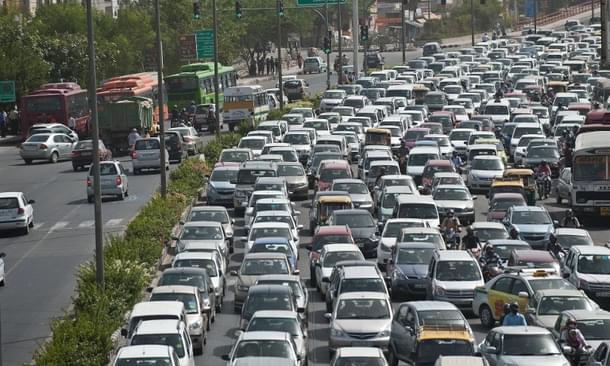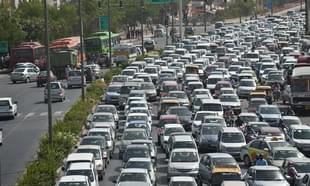Economy
Here’s What Happened When Mexico City Tried A Plan Similar To Kejriwal’s Odd-Even Car Rule
Aditya K
Oct 31, 2018, 04:32 AM | Updated 04:32 AM IST
Save & read from anywhere!
Bookmark stories for easy access on any device or the Swarajya app.


Perhaps the best feature of AAP 2.0 is that on every dimension, except in their ambition towards 2019, it is considerably more pragmatic and less idealistic. While some of the old supporters might resent this change of course, it is understandable as to why Kejriwal, with his eyes firmly set on 2019, desperately needed this change in direction. At any rate, this is a rather welcome change from the “Yahi to scam hai” days of the yore.
AAP has managed a remarkably high number of well-wishers from the policy circles due to their ideological positioning. I had thought, therefore, that AAP 2.0 would be a decent success in terms of creative policymaking. Admittedly, governance is a difference animal where I don’t give AAP much of an edge. One avenue where Kejriwal could have shown some creativity by taking help from his well-wishers from various circles was in curbing the beast of pollution.
The pressure on Delhi government to do something about the extremely dangerous levels of pollution in the city had been rising for a few months. Admittedly, it’s unfair to ascribe even an iota of blame on the genesis of this problem to Kejriwal. It is like blaming unfortunate communal incidents post-2014 to Modi. But then, in public life, and especially in India’s public life, logic, reason and facts are rarely of much use. What matters is perception; creating an impression of, “Yes, we’re working on it”.

It is astonishing to see how favorably the public is disposed if you only give out an impression of a humble person trying very hard to change things on ground. Kejriwal, in his second avatar, is doing precisely this. And it is through this prism that I see the policy of restrictions on private vehicle usage. In a nutshell, a person will be allowed to use his car only on odd or even days depending on whether the last digit of his is odd or even.
While the jury is out on whether this is a good initiative or not, what’s unfortunate is given the kind of support Kejriwal enjoys from experts in policy circles, he could still not bother coming up with something that, at least, does not have the precedence of being an absolute failure. Yes, there’s a precedence to such a policy and the outcome was nothing short of a disaster.
There’s a very famous paper by Lucas Davis from the University of Michigan on one such policy of restricting vehicle usage in Mexico to curb air pollution. Exactly like Delhi, Mexico City had an alarmingly high rate of pollution and in 1989, the Mexico City introduced a program called Hoy No Circula (HNC) that bans drivers from using their vehicle on one particular day of the week depending on the last digit of their number plate. Sounds very similar to Delhi, doesn’t it? The result?
To quote from the paper:
Across pollutants and specifications there is no evidence that the program has improved air quality. The policy has caused a relative increase in air pollution during weekends and weekday hours when the restrictions are not in place, but there is no evidence of an absolute improvement in air quality during any period of the week for any pollutant. Evidence from additional sources indicates that HNC led to an increase in the total number of vehicles in circulation as well as a change in composition toward high-emissions vehicles.
Astonishing isn’t it?
To give a brief background, the program (HNC) forced the drivers to not use their cars on one workday per week. The restrictions applied to the entire Mexico City metropolitan area and the program was very diligently implemented. There was a fine of $200 for violations which, often, were avoided through bribes. But then, as we can guess from our Indian experience, it’s still a hassle and the cost of bribes is also substantial.
The paper uses some of the most sophisticated techniques, called Regression Discontinuity (RD). Essentially the paper focusses on the eight year window of 1986-1993 to study air pollution levels across various pollutants. In a nutshell, the finding is that there is no appreciable change in pollution due to the introduction of HNC. There is no effect on pollution level of any major pollutant on any workday of the week. Even more starkly, the authors also look at the maximum pollution level during the day and see if that has come down post-HNC. Turns out, no effect. They see if the number of days on which the pollution levels exceed WHO standards has gone down post-HNC. Again, no effect.
One can go on and on about enumerating a thousand other aspects on which the performance of HNC was measured and it was found to have no impact.

Aerial View of Mexico City. Photo: Fidel Gonzalez
Interestingly, one would think that HNC would increase public transportation ridership. But it was actually found that the subway ridership reduced and in a statistically significant way. Why? Possibly because one needs to use a vehicle to get to the subway. Once that’s banned, people change their modes of transport altogether.
Here’s what actually happened. The authors look at the vehicle registration and vehicle sales data and, lo behold, both the new vehicle sales and registered vehicle sales increased post HNC in a statistically significant manner.
What it means that HNC had a causal impact on the trend of new vehicle sales as well as registration of vehicles which happens when old vehicles are sold from one person to the other. The number of registered vehicles increased significantly post-HNC. In fact, an overwhelmingly large increase in registered vehicle sales was composed of used vehicles.
Since old vehicles have higher emission levels this had an exclusively negative impact on the air quality. In fact, there’s a statistically significant negative impact on pollution levels on weekends and off-peak hours when HNC does not apply. This could be a result of older vehicles being used more.
What does this mean for Delhi? As I said the jury is still out. What happened in Mexico City need not happen in Delhi. But the best we can do is to take a guess on what could happen. First, the restrictions in Delhi are far harsher than in Mexico where a vehicle usage was barred only for a day of the week. In Delhi, the drivers will have to find other alternatives. One of it is going to be Kejriwal’s most dedicated vote-banks, the Autowallahs. As the paper says in its conclusion section,
“Although the particular experiences will differ across contexts, the overall pattern of adaptation observed in Mexico City is likely to be repeated elsewhere. Drivers everywhere have a revealed preference for fast and convenient transportation and will find ways to circumvent rationing programs of this form. Depending on the emissions characteristics of available alternatives these changes in behavior can seriously undermine the potential benefits.”
My guess is this is exactly what we will see. Think about what the policy is incentivizing. On the face of it, the claim is it incentivizes public transport. But what we know from Mexico is it doesn’t.
First, if the policy continues for a while, there will be a huge incentive for households to own two-cars with odd & even registration numbers. Evidently, this will have cost implications for the households and therefore, they will go for used, cheaper vehicles that will cause more pollution. I am willing to bet that this is what we will see if the policy continues.
Second, autos and taxis operators will enjoy an increased demand. Anyone who has spent some time in Delhi would know how terrible is the experience of dealing with Delhi autowallahs.
Now, with an added bargaining power, one can only sympathize with the ordeal of Delhites. At any rate, I would be more than shocked if the pollution levels are actually affected due to this policy. Make no mistake, two-weeks is too little a time for people to adjust. And so I won’t be shocked if at the end of two-weeks we see lower pollution levels. I do not know how responsive pollution is but if it is, I can expect lower pollution levels. But once the policy stays for a while I am fairly confident that people will find alternatives that do not involve public transport.
Sometimes paying attention to some of the research in economics helps. Sure, people aren’t the all-knowing-super-rational agents as assumed in economic models. But they are pretty damn smart. That is why giving the right incentives matter.
A miserable engineer turned into a PhD student in economics. He enjoys decision theory, matching, game theory. Other interests include maths and cricket.





